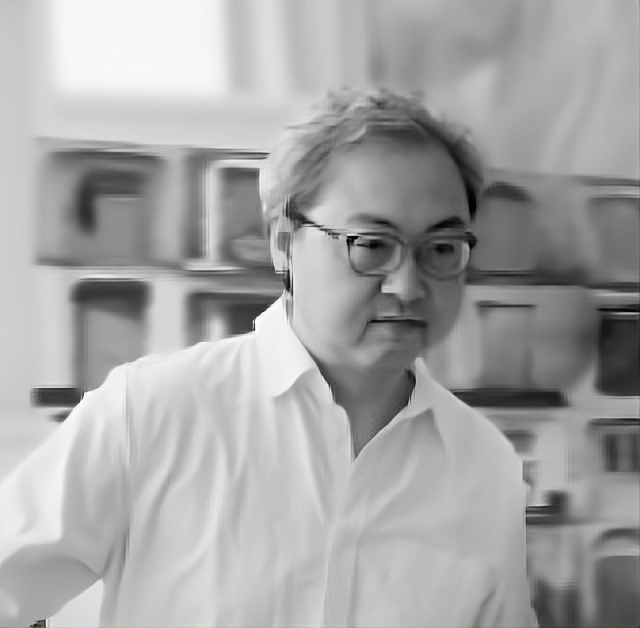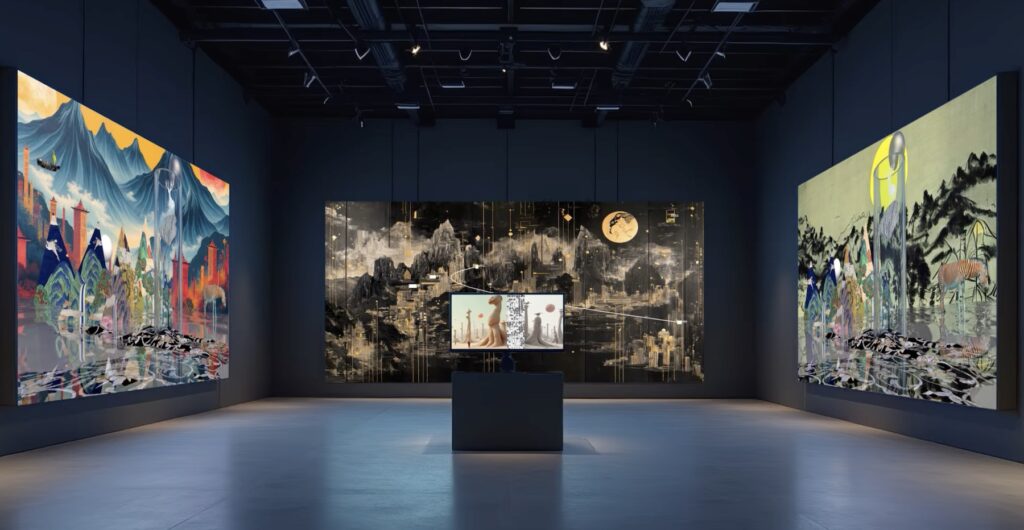Pau Waelder

Tahn (Taeyoung Ahn, born in South Korea, 1967) is a multifaceted media artist, technologist, writer, and art educator with an extensive career that spans multiple disciplines. Currently a Ph.D. candidate in Media Contents, Tahn’s academic journey includes a degree from the Global Media Contents department at Chungnam National University in Korea, as well as studies in psychology, modern dance, and interactive multimedia, the latter pursued in the United States.
In his professional roles, Tahn serves as a concurrent professor in liberal arts and contemporary arts at Seowon University and holds the position of Chairman of the United Art Education Association in Korea. He also contributes as a lecturer in sculpture and art at Chungbuk National University, where he imparts his expertise to the next generation of artists.
Throughout his career, Tahn has exhibited his work in prestigious group and solo exhibitions across cities such as Seoul, Daegu, Rome, Uzès, Lisbon, and New York.
Tahn recently presented on Niio his solo artcast Tales of the Five Peaks, and kindly answered a series of questions about his work and his perspective on the Korean contemporary art scene.
Tahn. Ilwolobongdo_parallel universe, 2024
You have a strong background in painting and sculpture but decided to move into digital media. How did this transition come about? What do you find most interesting about traditional techniques (such as painting and sculpture) on one side, and working with computers on the other?
For me, the distinction between traditional media and digital media is not particularly significant. I see painting, sculpture, digital devices, and other tools simply as instruments that artists of any era can use to convey the stories of their time. As an artist, I believe it is important to utilize every available resource to best express the narrative of the present. This philosophy naturally led me to include digital media in my work, alongside traditional materials such as brushes, paint, and canvas. I consider this fusion a natural evolution of artistic expression. While it might be described as a blend of traditional and digital techniques, to me it is just an inevitable expansion that allows me to fully articulate contemporary stories.
“As an artist, I believe it is important to utilize every available resource to best express the narrative of the present.”
When you started creating digital art, what was the reaction of your peers, collectors and followers? Was it well received? Would you say that, during the last decades, digital art has been well received in the Korean contemporary art scene?
When I introduced digital elements into Korean folk painting, especially in the ‘minhwa’ series, the reactions were extremely polarized. Traditional art groups, some associations, and juries at art contests refused to recognize my work as ‘minhwa’ because I did not adhere to conventional methods. However, I continued my work because I believed that the essence of ‘minhwa’ lies in being art for the people. During the Joseon Dynasty, minhwa was created for the public, and today the public is the digital-native MZ generation. Therefore, I use digital media to connect with them while preserving the essence of minhwa. Today, I am recognized as a leading media artist in the field of minhwa, redefining its place in contemporary art.
Tahn. Ilwolobongdo_today and tommorow, 2023
“When I introduced digital elements into Korean folk painting, especially in the ‘minhwa’ series, the reactions were extremely polarized.”
As a professor and lecturer at Seowon University and Chungbuk National University, you teach to the younger generation of artists and creators. What are their expectations about creating art, and what differences do you see from previous generations in their understanding of the history of art and the career paths that they want to follow?
One notable difference is that the younger generation is more open to exploring various ways of interpreting their time. To guide them, I emphasize the importance of studying the historical context and understanding how previous generations expressed their issues through art. For instance, by examining classical works, particularly traditional paintings, students can reflect on how past artists conveyed their era and what they can learn from them.
Through this process, I encourage students to create narratives that connect traditional techniques with modern tools like AI. My goal is to help them produce art that addresses contemporary issues while also drawing from cultural heritage, thereby creating something meaningful for today’s audience.
“My goal is to help students produce art that addresses contemporary issues while also drawing from cultural heritage.”
The contrast between the built environment (cities, buildings) and nature is a recurring theme in your work. What do you find most interesting about exploring this subject?
In Korea, we have a long history of garden culture (Jeongwon). Historically, scholars would leave the city and build small dwellings in nature, creating gardens where they could reflect on life, engage in philosophical thought, and formulate political ideas. Those who couldn’t leave the city would bring nature into their urban homes by creating small ponds and gardens in their courtyards. If even that wasn’t possible, they would hang landscape paintings in their rooms to simulate the presence of nature. This desire for nature amidst urban life led me to explore how human beings, even while residing in cities, inherently seek out nature. My interest in this topic began with traditional Korean painting and has expanded globally through my experiences in South Korea and the UK.

“The desire for nature amidst urban life led me to explore how human beings, even while residing in cities, inherently seek out nature.”
Fantastic, surreal, and sci-fi elements are also commonly present in your work. Can you elaborate on your choice of these references? Would you say that the use of 3D software has inspired you to incorporate these elements into your work?
Korean folk painting (‘minhwa’), folklore, and shamanistic beliefs have always contained fantastic and surreal elements—not as mere illusions but as symbols that help sustain the reality of people’s lives. These elements serve as hope, faith, and guiding principles for many individuals. To me, these objects are not simply products of imagination but are deeply rooted in real stories. The recent advancements in generative AI software, along with 3D software like Blender and Cinema 4D, have made it easier to translate these elements into tangible, hyper-realistic forms, thereby amplifying their impact on the viewer.
Tahn. Sustainable Today’s Story, Palace of Imagination no1, 2021
Although your digital artworks may seem to depict an imaginary world, they address real issues of our world, such as environmental degradation, and notably, also express feelings of hope and perseverance. Do you think that it is precisely by depicting imaginary scenes that one can invite the viewer to consider their own reality?
Absolutely. Every individual carries their own universe within them. By presenting an imaginative world beyond the viewer’s everyday reality, I invite them to explore the infinite dimensions of their inner selves. This creates a space where they can engage with emotions or thoughts that they might not have considered in their conventional reality. The imaginary worlds I create serve as mirrors—reflecting possibilities that encourage viewers to rethink their own perspectives and transcend the limitations of their current existence.
“Every individual carries their own universe within them. By presenting an imaginative world beyond the viewer’s everyday reality, I invite them to explore the infinite dimensions of their inner selves.”
Most of the artworks we currently present on Niio are related to the Ilwolobongdo, the painted folding screen that was always displayed behind the King’s throne in the Joseon Dynasty, depicting the Sun, the Moon, and the Five Peaks. Can you tell us about the significance of this particular object in Korean culture and art?
The Ilwolobongdo, the folding screen that symbolized the presence of the king during the Joseon Dynasty, represents authority and power. What intrigued me was the idea that the Ilwolobongdo was only complete when the king stood in front of it, suggesting that the individual and the environment together create a unified meaning. In today’s society, I believe that every individual is their own ‘king,’ a sovereign over their life and choices. By incorporating the Ilwolobongdo into my work, I hope to empower viewers, encouraging them to recognize their agency and the importance of their presence. Additionally, I include contemporary symbols and objects that represent today’s era, creating new narratives that link traditional motifs with the present and future.
Tahn. Sustainable environment, deer and whales, 2022
In some of your works we can see written text in Korean. Can you explain to us what these texts mean, and what is their role in your compositions?
The Korean text that appears in my works is often drawn from classical Korean poetry or my own poetic compositions. These texts add layers of meaning to the visual narrative, much like traditional Korean paintings that combine imagery and poetry—an essential skill for scholars during the Joseon era. By including these texts, I aim to create a dialogue between the visual and the poetic, merging artistic expressions that convey both aesthetic beauty and intellectual depth.
You also refer to Western culture in some artworks that depict objects such as an Evian water bottle, a Rolex watch, or an Apple computer, and you also place famous brand names such as Prada, Fendi, or Netflix on other objects. What is the purpose of including these brands and objects in your artworks?
I do not see these elements as uniquely ‘Western.’ Instead, they reflect the consumer tendencies around me, representing desires and aspirations within contemporary society. For instance, my series inspired by ‘chaekgado’ (a genre of Korean painting featuring bookshelves) originally had educational undertones in the Joseon era but gradually evolved to include luxury items, symbolizing changing values and desires. By incorporating these recognizable brands, I am commenting on the transformation of human values over time, as well as the transient nature of material possessions.
Tahn. Sustainable Today’s Story, Palace of Imagination no2, 2021
In some of your works, your name also becomes a brand, in a twist of the artist’s signature. Why did you choose to do so?
In traditional Korean art, the use of a seal (or ‘nakgan’) as an artist’s mark was a fundamental aspect of a painting. For me, incorporating my name as a brand is an extension of that tradition, reinterpreted in a modern context. Whether it’s through a literal signature, an avatar, or a unique object representing me, these inclusions are my way of putting a personal stamp on my work—merging historical artistic conventions with a contemporary twist.
You are currently using AI models to generate some of the elements in your work. Unlike other artists, who rely on machine learning for the creation of the whole work, you use the outputs of this process as an element that is seamlessly integrated into your 3D animations. Can you tell us more about your approach to using artificial intelligence in the creation of your artworks? How do you conceive a balance between “manual” creation by the human artist and algorithmic creativity?
As I explore the potential of generative AI, I often find myself reflecting on the evolving role of the artist in an age dominated by new technologies. AI is a powerful tool that aids in research, inspires new ideas, and adds complexity to certain aspects of my work. However, I am also cautious about the potential for AI to overshadow the artist’s unique voice. While I use AI-generated elements to enhance or complement my compositions, I ensure that the creative vision and narrative remain distinctly my own. AI, to me, is a resource—a collaborator, but not the creator. It is the artist’s hand that ultimately guides, curates, and gives soul to the work, distinguishing art from mere aesthetically pleasing products.
“AI, to me, is a resource—a collaborator, but not the creator. It is the artist’s hand that ultimately guides, curates, and gives soul to the work.”
